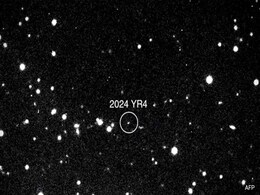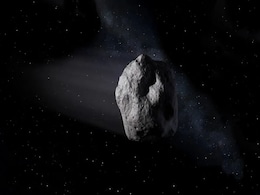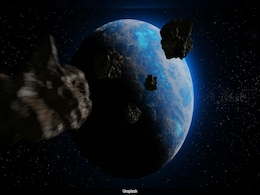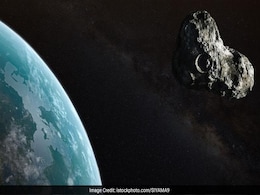Near Earth Asteroids
- All
- News
- Videos
-

Asteroid The Size Of Football Field Has Chance Of Hitting Earth In 8 Years
- Wednesday February 5, 2025
- World News | Agence France-Presse
It may sound apocalyptic, but a newly detected asteroid nearly the size of a football field now has a greater than one percent chance of colliding with Earth.
-
 www.ndtv.com
www.ndtv.com
-

Study Reveals Earth's Small Asteroid Likely Originated from the Moon
- Monday January 27, 2025
- Written by Gadgets 360 Staff
Asteroid 2024 PT5, discovered near Earth in 2024, is suspected to be a fragment from the Moon’s surface. Researchers found its composition matches lunar rock samples, specifically silicate-rich materials, unlike any known asteroid. Analysis from NASA’s Center for Near Earth Object Studies confirmed it is a natural object, not human-made debris,...
-
 www.gadgets360.com
www.gadgets360.com
-

Christmas Eve Asteroid Alert: 120-Foot Space Rock Racing Toward Earth
- Friday December 20, 2024
- Science | Edited by Nikhil Pandey
With a size of 120 feet and a close approach on December 24, this asteroid will pass safely at a distance of 4.48 million miles.
-
 www.ndtv.com
www.ndtv.com
-

An Asteroid Burned Up Over California Just Hours After Being Spotted
- Thursday November 14, 2024
- Written by Gadgets 360 Staff
On October 22, 2024, asteroid 2024 UQ was detected just hours before entering Earth’s atmosphere over the Pacific Ocean, near California. The ATLAS survey detected it shortly before impact, but delayed tracking data prevented immediate monitoring. The European Space Agency’s Near-Earth Object Coordination Centre later confirmed the asteroid's e...
-
 www.gadgets360.com
www.gadgets360.com
-

NASA’s 15-Year-Old NEOWISE Spacecraft Re-Enters Earth's Atmosphere After 15 Years in Space
- Wednesday November 6, 2024
- Written by Gadgets 360 Staff
NASA's NEOWISE spacecraft, originally launched as WISE in 2009, has ended its mission after nearly 15 years in operation. It successfully identified around 3,000 near-Earth objects and contributed significant data to the scientific community. NEOWISE's demise was attributed to the current solar maximum, leading to its atmospheric re-entry. As NEOWI...
-
 www.gadgets360.com
www.gadgets360.com
-

Earth's Temporary Second Moon: Asteroid 2024 PT5's Two-Month Orbit Explained
- Wednesday September 25, 2024
- Written by Gadgets 360 Staff
Asteroid 2024 PT5 will soon become Earth’s temporary second moon, entering orbit on September 29 and departing by November 25. While this mini-moon won't complete a full orbit, it will be caught in Earth’s gravitational pull for nearly two months. Unlike other celestial objects, this asteroid will be too dim to observe without advanced equipmen...
-
 www.gadgets360.com
www.gadgets360.com
-

Nuclear X-rays Could Deflect Asteroids and Protect Earth, Study Suggests
- Wednesday September 25, 2024
- Written by Gadgets 360 Staff
Researchers from Sandia National Laboratories have discovered that exploding a nuclear bomb near an asteroid may produce X-rays powerful enough to push it off course. Instead of blowing the asteroid apart, the method involves vaporising its surface to alter its trajectory. Using the Z Machine, the world’s most powerful X-ray source, they successf...
-
 www.gadgets360.com
www.gadgets360.com
-

Could Earth Have Had Rings Like Saturn? Study Suggests Asteroid Breakup and Cooling Climate
- Wednesday September 18, 2024
- Written by Gadgets 360 Staff
Scientists have proposed that Earth may once have had a ring system similar to Saturn’s, formed by an asteroid breakup 466 million years ago. This ring may have triggered global cooling, contributing to the Hirnantian Ice Age. Evidence includes impact craters near the equator and meteorite debris in sedimentary rocks.
-
 www.gadgets360.com
www.gadgets360.com
-

2024 KN1: Plane-Sized Asteroid To Zoom Past Earth Today. What NASA Said
- Sunday June 23, 2024
- Science | Edited by Ritu Singh
This celestial visitor named 2024 KN1, the size of an 88-foot aeroplane, is travelling at a speed of approximately 16,500 kilometres per hour.
-
 www.ndtv.com
www.ndtv.com
-

A 250-Feet Asteroid Coming Near Earth At 63,683 Kmph. All You Need To Know
- Monday May 13, 2024
- Science | Edited by Anoushka Sharma
Asteroid 2024 JB2 is a part of the Apollo group and has an astonishing speed of 63,683 kilometres per hour, NASA's CNEOS data stated.
-
 www.ndtv.com
www.ndtv.com
-

NASA Launches Spacecraft To Intercept 'God Of Chaos' Asteroid As It Nears Earth's Orbit
- Wednesday December 27, 2023
- Science | Edited by Ritu Singh
The asteroid Apophis also known as ''God of Chaos'' is expected to fly by Earth on April 13, 2029, from about only 20,000 miles away.
-
 www.ndtv.com
www.ndtv.com
-

Aircraft-Sized Asteroid Racing Towards Earth, Closest Approach Today
- Tuesday September 12, 2023
- Science | Edited by Amit Chaturvedi
2023 RO1 has passed by the Earth before, but this is the closest-ever approach to the planet, as per NASA data.
-
 www.ndtv.com
www.ndtv.com
-

Airplane-Sized Asteroid Nearing Earth Today, Says NASA
- Monday May 1, 2023
- Feature | Edited by Amit Chaturvedi
Asteroid 2023 HY3 is travelling at a speed of 23,596 kilometres per hour and will pass by Earth at a distance of 6.3 million kilometres.
-
 www.ndtv.com
www.ndtv.com
-

Asteroid The Size Of Football Field Has Chance Of Hitting Earth In 8 Years
- Wednesday February 5, 2025
- World News | Agence France-Presse
It may sound apocalyptic, but a newly detected asteroid nearly the size of a football field now has a greater than one percent chance of colliding with Earth.
-
 www.ndtv.com
www.ndtv.com
-

Study Reveals Earth's Small Asteroid Likely Originated from the Moon
- Monday January 27, 2025
- Written by Gadgets 360 Staff
Asteroid 2024 PT5, discovered near Earth in 2024, is suspected to be a fragment from the Moon’s surface. Researchers found its composition matches lunar rock samples, specifically silicate-rich materials, unlike any known asteroid. Analysis from NASA’s Center for Near Earth Object Studies confirmed it is a natural object, not human-made debris,...
-
 www.gadgets360.com
www.gadgets360.com
-

Christmas Eve Asteroid Alert: 120-Foot Space Rock Racing Toward Earth
- Friday December 20, 2024
- Science | Edited by Nikhil Pandey
With a size of 120 feet and a close approach on December 24, this asteroid will pass safely at a distance of 4.48 million miles.
-
 www.ndtv.com
www.ndtv.com
-

An Asteroid Burned Up Over California Just Hours After Being Spotted
- Thursday November 14, 2024
- Written by Gadgets 360 Staff
On October 22, 2024, asteroid 2024 UQ was detected just hours before entering Earth’s atmosphere over the Pacific Ocean, near California. The ATLAS survey detected it shortly before impact, but delayed tracking data prevented immediate monitoring. The European Space Agency’s Near-Earth Object Coordination Centre later confirmed the asteroid's e...
-
 www.gadgets360.com
www.gadgets360.com
-

NASA’s 15-Year-Old NEOWISE Spacecraft Re-Enters Earth's Atmosphere After 15 Years in Space
- Wednesday November 6, 2024
- Written by Gadgets 360 Staff
NASA's NEOWISE spacecraft, originally launched as WISE in 2009, has ended its mission after nearly 15 years in operation. It successfully identified around 3,000 near-Earth objects and contributed significant data to the scientific community. NEOWISE's demise was attributed to the current solar maximum, leading to its atmospheric re-entry. As NEOWI...
-
 www.gadgets360.com
www.gadgets360.com
-

Earth's Temporary Second Moon: Asteroid 2024 PT5's Two-Month Orbit Explained
- Wednesday September 25, 2024
- Written by Gadgets 360 Staff
Asteroid 2024 PT5 will soon become Earth’s temporary second moon, entering orbit on September 29 and departing by November 25. While this mini-moon won't complete a full orbit, it will be caught in Earth’s gravitational pull for nearly two months. Unlike other celestial objects, this asteroid will be too dim to observe without advanced equipmen...
-
 www.gadgets360.com
www.gadgets360.com
-

Nuclear X-rays Could Deflect Asteroids and Protect Earth, Study Suggests
- Wednesday September 25, 2024
- Written by Gadgets 360 Staff
Researchers from Sandia National Laboratories have discovered that exploding a nuclear bomb near an asteroid may produce X-rays powerful enough to push it off course. Instead of blowing the asteroid apart, the method involves vaporising its surface to alter its trajectory. Using the Z Machine, the world’s most powerful X-ray source, they successf...
-
 www.gadgets360.com
www.gadgets360.com
-

Could Earth Have Had Rings Like Saturn? Study Suggests Asteroid Breakup and Cooling Climate
- Wednesday September 18, 2024
- Written by Gadgets 360 Staff
Scientists have proposed that Earth may once have had a ring system similar to Saturn’s, formed by an asteroid breakup 466 million years ago. This ring may have triggered global cooling, contributing to the Hirnantian Ice Age. Evidence includes impact craters near the equator and meteorite debris in sedimentary rocks.
-
 www.gadgets360.com
www.gadgets360.com
-

2024 KN1: Plane-Sized Asteroid To Zoom Past Earth Today. What NASA Said
- Sunday June 23, 2024
- Science | Edited by Ritu Singh
This celestial visitor named 2024 KN1, the size of an 88-foot aeroplane, is travelling at a speed of approximately 16,500 kilometres per hour.
-
 www.ndtv.com
www.ndtv.com
-

A 250-Feet Asteroid Coming Near Earth At 63,683 Kmph. All You Need To Know
- Monday May 13, 2024
- Science | Edited by Anoushka Sharma
Asteroid 2024 JB2 is a part of the Apollo group and has an astonishing speed of 63,683 kilometres per hour, NASA's CNEOS data stated.
-
 www.ndtv.com
www.ndtv.com
-

NASA Launches Spacecraft To Intercept 'God Of Chaos' Asteroid As It Nears Earth's Orbit
- Wednesday December 27, 2023
- Science | Edited by Ritu Singh
The asteroid Apophis also known as ''God of Chaos'' is expected to fly by Earth on April 13, 2029, from about only 20,000 miles away.
-
 www.ndtv.com
www.ndtv.com
-

Aircraft-Sized Asteroid Racing Towards Earth, Closest Approach Today
- Tuesday September 12, 2023
- Science | Edited by Amit Chaturvedi
2023 RO1 has passed by the Earth before, but this is the closest-ever approach to the planet, as per NASA data.
-
 www.ndtv.com
www.ndtv.com
-

Airplane-Sized Asteroid Nearing Earth Today, Says NASA
- Monday May 1, 2023
- Feature | Edited by Amit Chaturvedi
Asteroid 2023 HY3 is travelling at a speed of 23,596 kilometres per hour and will pass by Earth at a distance of 6.3 million kilometres.
-
 www.ndtv.com
www.ndtv.com

















